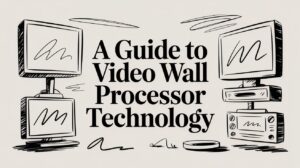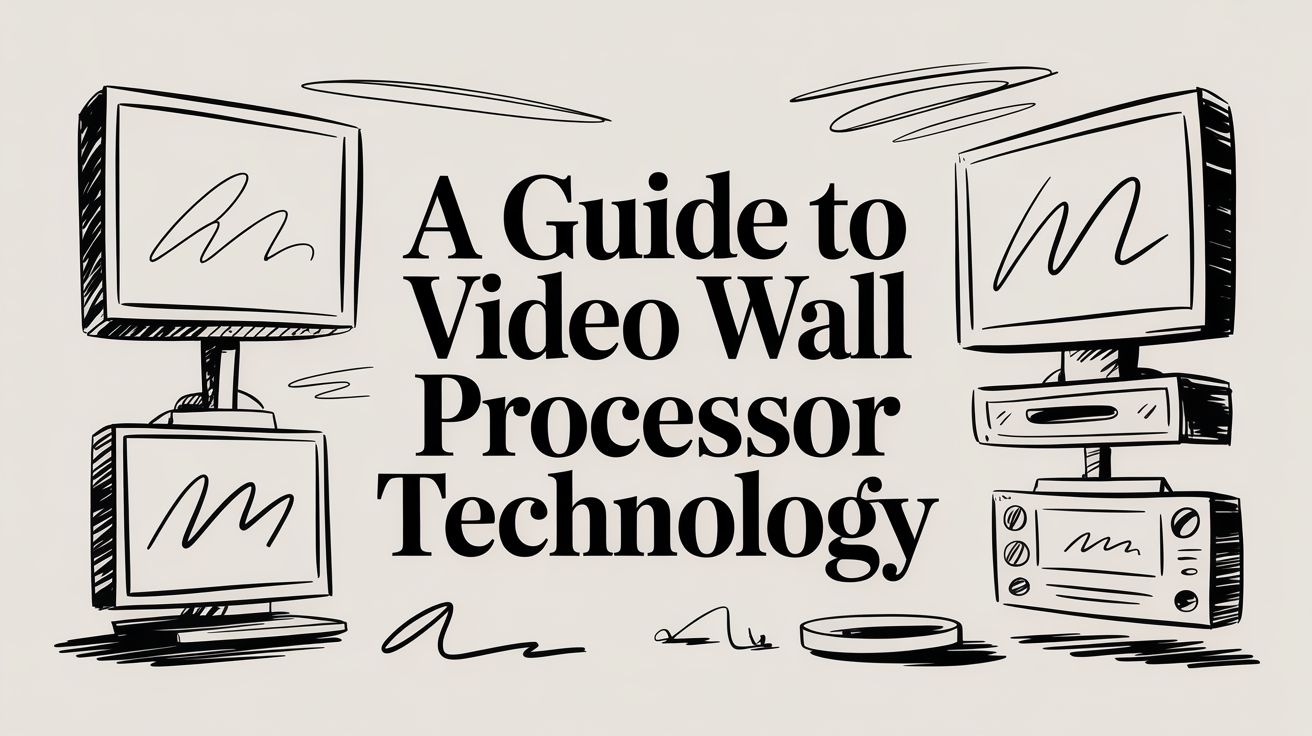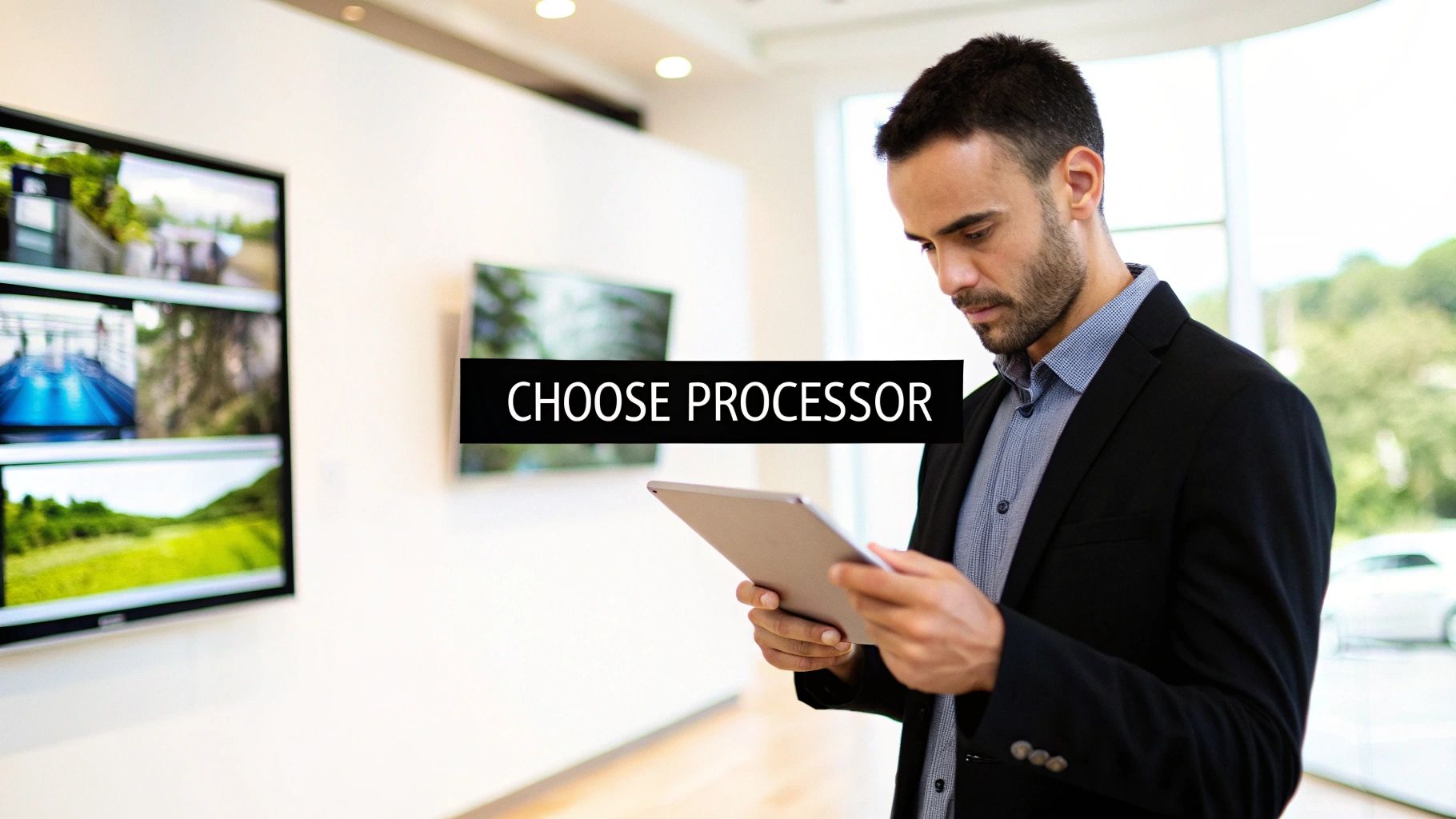
A Guide to Video Wall Processor Technology
So, what exactly is a video wall processor? Think of it as the brains of the operation for any large-scale, multi-screen setup. It’s the central

So, what exactly is a video wall processor? Think of it as the brains of the operation for any large-scale, multi-screen setup. It’s the central command hub that grabs video from all your different sources and masterfully arranges them into one big, beautiful, seamless picture.
It’s less like a simple signal splitter and more like an orchestra conductor for your displays, making sure every single screen works in perfect harmony to create a massive, coordinated canvas. A processor is the powerful hardware that unlocks total creative control over what your audience sees.
Let's get practical. Imagine you need to show four different 24-hour news channels, a live feed from a security camera, and a scrolling stock ticker all at the same time on a giant 4×4 grid of screens. If you tried to do that without a central brain managing everything, you’d just have a jumbled, chaotic mess of signals.
This is the exact problem a video wall processor solves. It’s the piece of kit that ingests, processes, and sends out all your content, letting you treat a whole wall of individual displays as a single, dynamic surface.
At its core, a video wall processor is all about giving you ultimate flexibility. It lets you:
It’s easy to get a processor confused with a more basic controller or a simple video splitter, but they are worlds apart in what they can do. A splitter just takes one signal and clones it, sending the exact same thing to multiple screens. A basic controller might let you stretch one image across a few screens in a simple grid.
But a true video wall processor? That gives you a much, much deeper level of command.
A processor is a dynamic tool for managing and arranging content. A splitter is just a static tool for duplicating a signal. The right choice completely depends on whether you need to just mirror a screen or tell a complex, multi-source visual story.
The need for this kind of advanced control is blowing up. The global market for video wall processors, already valued at USD 1.5 billion, is on track to more than double. This trend shows just how vital processors have become for creating visual experiences that really make an impact in retail, control rooms, and beyond. You can dig into the industry growth and its connection to the wider AV sector on Verified Market Reports.
To really spell out the difference, let’s put them side-by-side.
This table breaks down the key differences to help you see why a dedicated processor is in a league of its own for complex projects.
| Feature | Video Wall Processor | Basic Controller or Splitter |
|---|---|---|
| Source Management | Manages multiple, simultaneous, independent sources | Manages one source, duplicated across outputs |
| Layout Flexibility | Allows fully custom, dynamic layouts (windowing) | Limited to basic grid layouts or simple mirroring |
| Scaling & Resolution | Advanced scaling to maintain quality across the wall | Basic scaling, often resulting in quality loss |
| Creative Control | High degree of creative and operational control | Minimal to no control over content arrangement |
| Best For | Control rooms, retail, live events, corporate lobbies | Simple digital menu boards, information displays |
As you can see, if your goal is to do anything more than show the same thing on a few screens, a processor isn't just a nice-to-have—it's an absolute necessity.
Think of a video wall processor as the director of a blockbuster movie. It takes all the different visual elements—live camera feeds, computer presentations, media players—and masterfully blends them into a single, stunning visual experience on your video wall. It’s the brains of the operation, ensuring every single pixel from every source lands exactly where it’s supposed to go.
The process kicks off the moment a signal hits the processor. No matter where it's coming from, the processor grabs it, digitizes it, and gets it ready for the main event. This is where the real magic happens, as all those separate inputs are converted into a unified format that can be sliced, diced, and arranged with incredible precision.
This infographic breaks down the workflow, showing how different sources are funneled through the processor before being sent out to the individual displays on the wall.

As you can see, the processor is the command center, managing the flow of content from multiple inputs to create one cohesive image across the entire display grid.
One of the most important jobs a video wall processor has is scaling. Let’s say you have a standard HD video (1920×1080), but your video wall is a massive 4K canvas (3840×2160). If you just stretched that smaller image to fit, it would look blurry, pixelated, and completely unprofessional. Nobody wants that.
A good processor intelligently scales the content up, using sophisticated algorithms to add pixels and sharpen the image so it looks crisp and vibrant on the bigger screen. It works the other way, too, flawlessly scaling down 8K content to fit a 4K wall without losing crucial detail. This ensures your visuals always look sharp, no matter the source.
To really get how video wall processors work their magic, it's key to understand all the potential inputs, including how streaming video from a server can affect the final display quality and performance.
Beyond just making one source look great across the whole wall, a truly powerful video wall processor excels at windowing. This is the ability to show multiple video sources at the same time, each in its own movable and resizable window.
Picture it like arranging apps on your smartphone screen, but on a massive scale. You could have a live news feed in one corner, a stock ticker scrolling along the bottom, your main presentation front and center, and a video conference call in another window. This kind of flexibility is a game-changer in places like:
The processor gives you a blank canvas and a palette of content. Windowing is the brush you use to paint your visual story, arranging elements exactly where they will have the most impact.
This freedom allows you to build dynamic, information-rich displays that you can change on the fly to meet whatever the moment demands.
When you line up multiple displays to build a video wall, you’re left with physical gaps created by the plastic frame—or bezel—around each screen. If you ignore them, an image stretched across the wall will look disjointed, as if chunks of it are missing behind the frames.
That’s where bezel compensation saves the day. The video wall processor is smart enough to "hide" the parts of the image that would normally fall on the bezels. It essentially creates a tiny, digital gap in the content that perfectly matches the physical gap between the screens.
The result? The image flows naturally and continuously from one display to the next, making it look like a single, seamless canvas. It’s a subtle but absolutely essential feature for creating a believable and immersive visual experience.
Trying to make sense of a video wall processor's spec sheet can feel like deciphering a secret code. You're hit with a wall of acronyms and numbers, but getting a handle on these details is the only way to choose the right hardware for your project. It's like checking the engine specs before buying a car—you have to know what's under the hood to make sure it can actually deliver the performance you need.
The most basic starting point is the number and type of inputs and outputs (I/O). This spec tells you exactly how many different sources you can plug in (inputs) and how many individual screens or cabinets you can drive (outputs). It’s a simple numbers game: if you need to show content from six different computers on a 16-screen wall, your processor needs at least six inputs and 16 outputs. Simple as that.
The global video wall processor market is currently valued at around $4.356 billion and is expected to grow at a healthy 12.5% each year. This isn't just a random trend; it's being driven by a massive demand for more powerful processors that can handle a ton of I/O in places like corporate boardrooms, control rooms, and large-scale digital advertising. You can find more market insights on Data Insights Market.
Resolution is all about the clarity and detail of your image. A processor’s spec sheet will list the maximum resolution it can handle for each input and output, like 4K (3840×2160) or even 8K (7680×4320). Higher resolution means a sharper, more detailed picture, which is non-negotiable if you want to make a real visual impact.
But don't stop there. The total pixel load capacity is just as crucial. A processor might say it supports 4K inputs, but can it actually power a huge 5×5 video wall where the total resolution blows past what a single 4K signal can handle? This is where high-end models really shine. A beast like a 16-port processor with a 10-million pixel load capacity is built from the ground up to manage these massive pixel canvases without even breaking a sweat.
EDID Management: This often-overlooked feature is the unsung hero of a reliable setup. EDID (Extended Display Identification Data) is basically a digital handshake. It’s how your source device (like a laptop) tells a display what resolutions and refresh rates it supports. A processor with solid EDID management prevents those dreaded flickering screens, blackouts, and resolution mismatches by making sure that handshake is always perfect.

To really nail down the right processor, it helps to break down the key specs and understand what they actually mean for your project. This table cuts through the jargon.
| Specification | What It Is | Why It Matters |
|---|---|---|
| Inputs/Outputs (I/O) | The number of source devices you can connect and the number of screens you can drive. | This is the foundation. You need enough I/O to match your sources and your display layout. Mismatch here and your project is a non-starter. |
| Max Resolution | The highest resolution (e.g., 4K, 8K) the processor can handle per input and output. | Higher resolution delivers a crisper, more detailed image. Crucial for high-impact visuals in retail or for detailed data in control rooms. |
| Pixel Load Capacity | The total number of pixels the processor can manage across the entire video wall. | A single 4K signal is about 8.3 million pixels. A large video wall can easily exceed this. High capacity is essential for massive or high-res displays. |
| EDID Management | The processor's ability to manage communication between source devices and displays. | Poor EDID leads to flickering, black screens, or wrong resolutions. Good EDID management ensures a stable, plug-and-play experience. |
| Bezel Compensation | A feature that accounts for the physical borders (bezels) of individual screens. | Without this, images look disjointed and warped across screens. It creates a single, seamless canvas by "hiding" content behind the bezels. |
| Multi-Window Support | The ability to show multiple video sources in different windows on the wall at the same time. | Essential for control rooms, broadcast studios, or collaborative meetings where you need to see multiple data streams at once. |
| Custom Aspect Ratios | Support for non-standard screen shapes, like ultra-wide 21:9 or vertical displays. | Standard 16:9 doesn't fit every space. This feature lets you create unique, artistic installations without stretching or distorting your content. |
Understanding these specs moves you from just picking a box with enough ports to strategically choosing a tool that will bring your vision to life.
Once you've got the basics of I/O and resolution covered, you can start looking at the features that really unlock creative potential. These are the capabilities that separate a boring grid of screens from a truly dynamic and unique visual experience.
Here are a few advanced features to keep an eye on:
By getting a handle on these core specs, you can move way beyond just counting inputs and outputs. You can start to truly envision what’s possible with your video wall and pick a video wall processor that not only meets the technical demands but also fuels your creative vision. It’s all about choosing a tool that gives you the power and flexibility to deliver your message with maximum impact.
A video wall processor is more than just a piece of gear; it’s the brain that powers incredible visual communication in all sorts of places. To really get a feel for its impact, we need to step away from the spec sheets and look at where these devices are making a real difference. By walking through a few key scenarios, you'll see exactly how their features solve tangible, everyday problems.
Picture a high-stakes environment like a security operations center or an energy grid control room. Information is everything. Operators are juggling dozens of simultaneous data feeds—security cameras, interactive maps, system diagnostics, live news—all at once. There is absolutely zero room for error or delay.
This is where a video wall processor becomes the central nervous system of the entire operation. Its ability to manage tons of inputs and arrange them in flexible, multi-window layouts is non-negotiable. An operator can instantly grab a critical camera feed, blow it up across the entire wall, and still keep all the other data streams in view. Features like seamless switching and low latency are critical, ensuring the information on screen is immediate and completely reliable.
Walk into a modern flagship store, and you're almost guaranteed to be hit with a massive, stunning video wall. These displays aren’t just playing ads; they're creating an immersive brand experience, pulling customers in with vibrant, high-impact visuals. The goal is to build an atmosphere that's memorable and engaging.
This is where a processor’s creative muscle really shines. It gives retailers the power to:
This tech lets a brand tell a compelling visual story that grabs attention and, ultimately, drives sales. We saw a similar need for unique, captivating visuals in a recent curved LED installation in Philadelphia, which you can read more about here.
The modern boardroom has changed. Meetings are now a mix of people in the room and others joining remotely, all needing to share content from different devices. A great presentation depends on being able to switch from a laptop to a video conference feed to a digital whiteboard without any technical hiccups.
A video wall processor turns a static presentation screen into an interactive, collaborative workspace. It wrangles the complexity of multiple sources, letting the tech fade into the background so the meeting can flow naturally.
The processor acts as a central hub, allowing several people to share their screens at the same time in different windows. Its solid EDID management ensures that any device just works when you plug it in, killing those frustrating delays and compatibility headaches. This creates a fluid environment where ideas, not technical issues, take center stage. For example, video wall processors are crucial for visual accuracy and teamwork in demanding post-production environments.
From concerts and music festivals to big-time award shows, live events rely on spectacular visuals to create an unforgettable experience. Those massive LED screens behind the stage are all powered by video wall processors that have to perform perfectly under immense pressure.
In this world, the processor’s job is to sync multiple video sources, live camera feeds, and real-time generative graphics into one cohesive, dynamic show. Key features here include:
The modular video wall processor market is booming, showing just how important these high-performance units are globally. The United States, for instance, is a major player, exporting around 500,000 units valued at $250 million each year—a clear sign of the strong international demand for reliable event technology.
Picking the right video wall processor can feel like a huge decision, but it doesn't have to be a headache. If you focus on what you actually want to achieve with your project, you can slice right through the tech-speak and find a solution that works for you now and in the future. It really all boils down to asking the right questions upfront.
Think of it like drawing up a blueprint for your visual experience before you even start looking at hardware. A crystal-clear understanding of your goals will lead you straight to the right processor, saving you from overspending on features you'll never touch—or worse, ending up with a unit that can't bring your vision to life.

Before you get lost in spec sheets, take a minute to nail down the basics. Your answers here will build the foundation for everything that follows.
How many sources will you display at once? This is the big one. If you just need to show a single computer screen blown up across the whole wall, your needs are pretty simple. But if you’re trying to display four camera feeds, two laptops, and a media player all at the same time, you're going to need a processor with serious multi-windowing muscle and enough inputs to juggle it all.
What is the total resolution of your video wall? Do the math and figure out the total pixel count of your entire display. A standard 2×2 wall of 1080p screens adds up to a 4K resolution (3840×2160). But if you're building a massive 5×5 grid, you'll need a processor with a much higher pixel capacity to keep the image sharp and avoid performance lag.
Do you need flexible, custom layouts? Think about whether you'll need to resize, move, and layer your video sources on the fly. A basic processor might lock you into fixed quadrant layouts. An advanced model, on the other hand, gives you the freedom to create dynamic, overlapping windows—an absolute must-have for control rooms and collaborative spaces.
With those answers in your back pocket, you can start translating them into technical specs. This is how you make sure you're comparing apples to apples when you look at different processor models.
Let's walk through a couple of real-world scenarios to see how these choices play out.
Scenario 1: The Simple Restaurant Menu Board
A restaurant wants to put up a 2×2 video wall to display a single digital menu from one computer. Their needs are clean and simple.
- Sources: One PC.
- Total Resolution: 4K (3840×2160).
- Layouts: One static image stretched across all four screens.
Processor Choice: A basic processor with one 4K input and four 1080p outputs is a perfect fit. They don't need multi-windowing, so the focus is all about reliability and ease of use.
Now, let's jump to the other end of the spectrum.
Scenario 2: The Corporate Command Center
A logistics company is building a 5×5 video wall for its 24/7 operations center. They have to monitor live GPS maps, multiple video conference feeds, data dashboards, and broadcast news—all at once.
- Sources: 8+ (PCs, cameras, web apps).
- Total Resolution: 9600×5400 (over 51 million pixels!).
- Layouts: Completely dynamic. Operators need to change layouts and highlight different sources in an instant.
Processor Choice: This is a job for a high-end, modular video wall processor. It needs at least eight inputs, 25 outputs, a massive pixel processing capacity, and powerful software for creating and recalling complex windowed layouts on the fly.
By clearly defining what you need from the very beginning, you can confidently choose a video wall processor that nails your requirements, ensuring your investment is a success today and well into the future.
When you're getting close to pulling the trigger on a video wall project, a few final questions always seem to pop up. Getting those last details ironed out is what gives you the confidence to move forward. Here, we'll tackle some of the most common things we get asked, cutting through the jargon to give you the practical answers you need.
Let's clear up the hardware vs. software debate, talk about what "lag" really means for your setup, and make sure you've got a handle on the operational details that make or break a project.
This is probably one of the first and most important questions you'll face. The real difference boils down to how each one handles the heavy lifting of managing all those video signals.
A hardware-based processor is a purpose-built machine, a dedicated box designed to do one thing exceptionally well: process video with insane speed and reliability. All the complex work—scaling, windowing, switching sources—happens on specialized computer chips. The result is almost zero lag and the kind of stability you can bet your job on, which is why it's the only real choice for mission-critical places like control rooms or live events.
On the other hand, a software-based processor runs on a beefed-up PC loaded with powerful graphics cards. It offers a ton of flexibility and can be a bit easier on the wallet for some uses. But here's the catch: it's all running on a standard operating system. That introduces variables, the potential for lag, and a higher risk of the whole thing crashing compared to a dedicated hardware unit.
"Latency" is just a technical term for that tiny, almost imperceptible delay between when a video signal is sent to the processor and when you actually see it on the screen. How much of that delay is "acceptable" depends entirely on what you're doing.
As a rule of thumb, any delay under 16-20 milliseconds is basically invisible to the human eye. But for anything interactive or live, your goal should always be to get that number as close to zero as possible. It's all about creating a seamless experience.
You bet. Modern video wall processors are built for exactly that. The days of being chained to a rack of equipment in a stuffy server room are long gone. Most professional-grade processors come with control software you can run from any PC on the same network.
This lets operators switch sources, design new layouts, and tweak settings from a comfortable control desk. Many of the more advanced systems even have APIs (Application Programming Interfaces) that let you tie them into big-name control systems like Crestron or AMX. Some even have dedicated apps for tablets and smartphones. This kind of remote access is a must-have for managing displays in large venues or when the processor itself is tucked away somewhere hard to reach.
This one comes up a lot. The answer is a classic: it depends. If all you want to do is stretch a single image or video across a simple four-screen setup, you might get away with a much simpler video wall controller or even just a PC with a multi-output graphics card.
But the second you want to do anything more interesting, a dedicated video wall processor becomes non-negotiable. You'll need a processor if you want to:
For anything beyond just mirroring a desktop, a processor gives you the horsepower and flexibility that simpler tools just can't touch.
Yes, and this is where the high-end, modular processors really shine. These beasts can be configured with multiple graphics and output cards, letting them power several completely separate video walls from a single chassis.
Think about a large company: they could use one centralized processor to run the massive video wall in their lobby, another in the main boardroom, and a third in their security operations center. This approach centralizes control, makes maintenance a breeze, and is often more cost-effective than buying and managing a separate box for every single display. It's the perfect setup for universities, corporate campuses, or event venues that need a cohesive, easily managed system.
Ready to bring your vision to life with a stunning LED video wall? The experts at Smart LED Inc. can help you choose the perfect display and processor to match your goals and budget. From dynamic retail signage to mission-critical control rooms, we deliver factory-direct solutions built for impact. Explore our high-performance indoor and outdoor LED displays today!

So, what exactly is a video wall processor? Think of it as the brains of the operation for any large-scale, multi-screen setup. It’s the central

So, what exactly is a professional led panel for video? Think of it less like a traditional TV and more like a high-tech, luminous building

When you're looking for a massive, high-impact display, an LCD video wall is often the first technology that comes to mind. It's a proven workhorse,
"*" indicates required fields